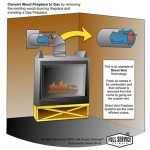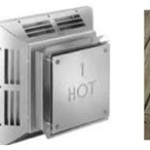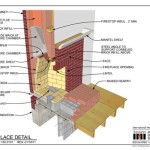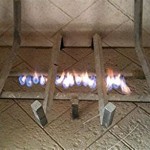Electric Hanging Fireplaces: A Modern Heating and Aesthetic Solution
Electric hanging fireplaces represent a contemporary evolution in home heating and design. Moving beyond traditional hearths and bulky stoves, these appliances offer a sleek, space-saving solution while providing the visual appeal of a real flame. Unlike gas or wood-burning fireplaces, electric hanging models require no venting, making installation significantly simpler and broadening their applicability to various interior spaces.
The core function of an electric hanging fireplace revolves around converting electrical energy into heat. Most units employ a heating element, often a coil or ceramic component, that warms up as electricity passes through it. A fan then circulates the heated air into the room, providing supplemental warmth. The flame effect, a crucial aspect of the visual appeal, is generally created through a combination of LED lighting and a rotating or vibrating mechanism. This mechanism reflects light off a simulated flame bed, which can be made of artificial logs, crystals, or other decorative materials, creating a realistic flickering effect.
The mounting hardware for electric hanging fireplaces is a critical element of their design. These units are typically suspended from the ceiling using a sturdy bracket and chain or rod system. The bracket must be securely anchored to a structural component of the ceiling, such as a joist, ensuring the fireplace's weight is adequately supported. The quality and strength of the mounting hardware are paramount for safety and stability.
Key Point 1: Advantages of Electric Hanging Fireplaces
Electric hanging fireplaces offer several advantages over traditional fireplace options. The absence of a chimney or venting system is a significant benefit, simplifying installation and reducing associated costs. This makes them suitable for apartments, condominiums, and homes where installing a conventional fireplace would be impractical or impossible. Furthermore, electric fireplaces are inherently more energy-efficient than their gas or wood-burning counterparts, as they convert nearly 100% of the electricity they consume into heat. This efficiency can translate to lower heating bills, especially when used as supplemental heating in specific rooms.
Safety is another notable advantage. Electric fireplaces eliminate the risk of carbon monoxide poisoning, which is a concern with gas fireplaces. They also lack the open flame and hot surfaces associated with wood-burning fireplaces, reducing the risk of burns, embers, and fire hazards, especially important in households with children or pets. Many models also feature overheat protection, automatically shutting off the unit if it reaches an unsafe temperature.
Aesthetic flexibility is a key draw for many consumers. Electric hanging fireplaces are available in a wide range of styles, sizes, and finishes, allowing homeowners to choose a model that complements their existing decor. The flame effect can often be customized, with adjustable brightness, color, and speed settings. Some units even offer multiple flame effect options, allowing users to change the ambiance to suit their mood or preference. Moreover, the visual appeal of a hanging fireplace adds a unique focal point to a room, enhancing its overall aesthetic appeal.
Key Point 2: Installation Considerations
While electric hanging fireplaces are generally easier to install than traditional fireplaces, careful planning and execution are essential for a safe and successful installation. The first step is to determine the appropriate location for the fireplace, considering factors such as room size, furniture placement, and available electrical outlets. It is crucial to ensure that the location provides adequate clearance around the fireplace, preventing flammable materials from coming into contact with the heating element.
Before installing the mounting bracket, it is imperative to verify that the ceiling structure can support the weight of the fireplace. This typically involves locating a ceiling joist and securely attaching the bracket to it using appropriate hardware. If the ceiling is not structurally sound, reinforcement may be necessary. Consulting with a qualified contractor or structural engineer is recommended in cases of uncertainty.
Electrical considerations are also crucial. The electric fireplace should be plugged into a dedicated electrical outlet with the correct voltage and amperage. Avoid using extension cords, as they can overheat and pose a fire hazard. If a dedicated outlet is not available, a qualified electrician should install one. It is also advisable to check local building codes and regulations to ensure compliance with electrical safety standards.
Once the mounting bracket is securely installed and the electrical connections are established, the fireplace can be carefully hung from the bracket using the provided chain or rod system. Ensure that the fireplace is level and stable before turning it on. It is also recommended to test the fireplace to verify that it is functioning correctly and that the fan is circulating air properly.
Key Point 3: Maintenance and Care
Electric hanging fireplaces require minimal maintenance compared to traditional fireplaces. However, regular cleaning is essential to ensure optimal performance and longevity. The exterior of the fireplace can be cleaned with a soft, damp cloth. Avoid using abrasive cleaners or solvents, as they can damage the finish.
The flame effect mechanism may require periodic cleaning to remove dust and debris that can accumulate over time. This typically involves removing the simulated flame bed and gently cleaning the rotating or vibrating components with a soft brush or vacuum cleaner. Refer to the manufacturer's instructions for specific cleaning recommendations.
The heating element and fan may also require occasional maintenance. Check the heating element for signs of damage or wear, such as discoloration or cracking. Clean the fan blades regularly to remove dust and debris that can impede airflow. If the fan is making unusual noises or not circulating air properly, it may need to be replaced.
Regularly inspect the electrical cord and plug for signs of damage, such as fraying or cracks. If any damage is detected, the cord or plug should be replaced immediately by a qualified electrician. Avoid using the fireplace if the electrical cord is damaged, as it can pose a fire hazard.
Finally, it is important to follow the manufacturer's recommendations for maintenance and care. Consult the owner's manual for specific instructions on cleaning, troubleshooting, and replacing components. Proper maintenance will help ensure that your electric hanging fireplace continues to provide safe and efficient heating and aesthetic enjoyment for years to come.
Beyond the practical considerations, the selection of an electric hanging fireplace should also align with the homeowner's overall design vision. Models featuring sleek, minimalist designs with glass fronts can complement modern interiors, while those with ornate frames and faux brick surrounds may be more suitable for traditional spaces. The choice of flame bed material, whether it be artificial logs, crystals, or pebbles, further contributes to the fireplace's aesthetic impact.
The integration of smart home technology is also becoming increasingly common in electric fireplaces. Some models offer remote control functionality, allowing users to adjust the temperature, flame effect, and timer settings from a smartphone or tablet. Voice control integration with platforms like Amazon Alexa or Google Assistant is also available on some models, adding a layer of convenience and automation.
Electric hanging fireplaces, therefore, represent a confluence of practicality, safety, and aesthetic appeal, making them a compelling option for homeowners seeking a modern heating and design solution. Their ease of installation, energy efficiency, and minimal maintenance requirements contribute to their growing popularity. As technology continues to advance, these fireplaces are likely to become even more sophisticated, offering enhanced features and greater customization options.

Malm High Sierras Mid Century Modern Electric Fireplace Ventless Mcm F Smokey Mountain Fireplaces

Napoleon Azure 38 In Vertical Black Wall Mount Electric Fireplace Fireplaces Direct

Real Flame Corretto 72 In Electric Wall Mount Fireplace Black 1360e Bk The Home Depot

60 Inch Recessed Wall Mounted Electric Fireplace 750 1500w Remote Oneinmil

Hanging Fireplaces Archis

Napoleon Alluravision Series Electric Logs Fireplace Insert Hearth Stove Patio

Recessed Or Wall Mount Electric Fireplace Installations Explained Touchstone Home S Inc

Classic Flame Helen 48 In Wall Mount Electric Fireplace Black 48hf320fgt The Home Depot

Fodinghill 60 Insert Wall Mounted Electric Fireplace Low Noise Heater Mantel Features A Touch Screen 700w 1400w Com

Clihome Flame 30 In Wall Mounted Automatic Constant Temperature Electric Fireplace Insert Ef30r The Home Depot
Related Posts








